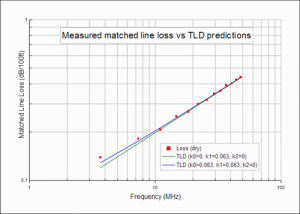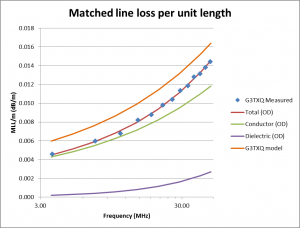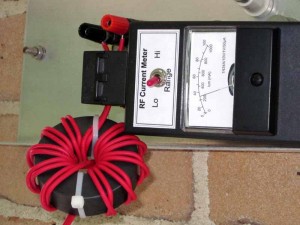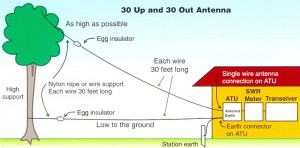I tried to glean some useful information from G3TXQ’s measurements of windowed ladder line loss at Windowed ladder line loss – G3TXQ.
In reviewing his article today (05/02/14), there is new information on a further series of measurements of the same line.

The shape and position of the two lines does not reconcile with the formulas stated, so I digitised the data points and analysed the data set to try to find the most appropriate model for the reported measurements. Note that although the chart above is in imperial units, my work is usually in ISO metric units, and usually basic units.
The digitised data points were converted to loss in dB/m, and fitted to the model MLL=k0+k1*f^0.5+k2*f using regression techniques. Note that the digitisation process introduces some noise, but it is estimated to be small compared to the noise in the underlying measurement data.
The coefficients k0, k1, k2 were reviewed to test that there was sufficient data to support the hypothesis that they were not zero, and all three passed that test, the standard error of the coefficient was significantly less than the coefficient. Note that k0 is not derived from a DC measurement of resistance as done by some modellers, but from the measurement data over the range of 3.6 to 48MHz in this case, and extrapolation beyond that frequency range increases uncertainty.

The above chart shows G3TXQ’s measurements as digitised from his published graph, and it shows the components of loss indicated from the model I built (the k0 component is allocated as conductor loss).
The “G3TXQ model” line is equivalent to his MLL=0.063+0.063*f^0.5 dB/100′ converted to dB/m, and as you can see it is not a good fit to the measurement data points, nor does MLL=0.063+0,063*f^0.5 dB/100′ reconcile with the blue line on G3TXQ’s chart earlier in this article.
G3TXQ’s measurement points (as digitised) are quite a good fit to the model MLL=0.001456+1.499e-6*f+5.631e-11*f dB/m where f is in Hz, and provide a good predictor of MLL over 3.6 to 48MHz.
Last update: 5th February, 2014, 2:53 PM







